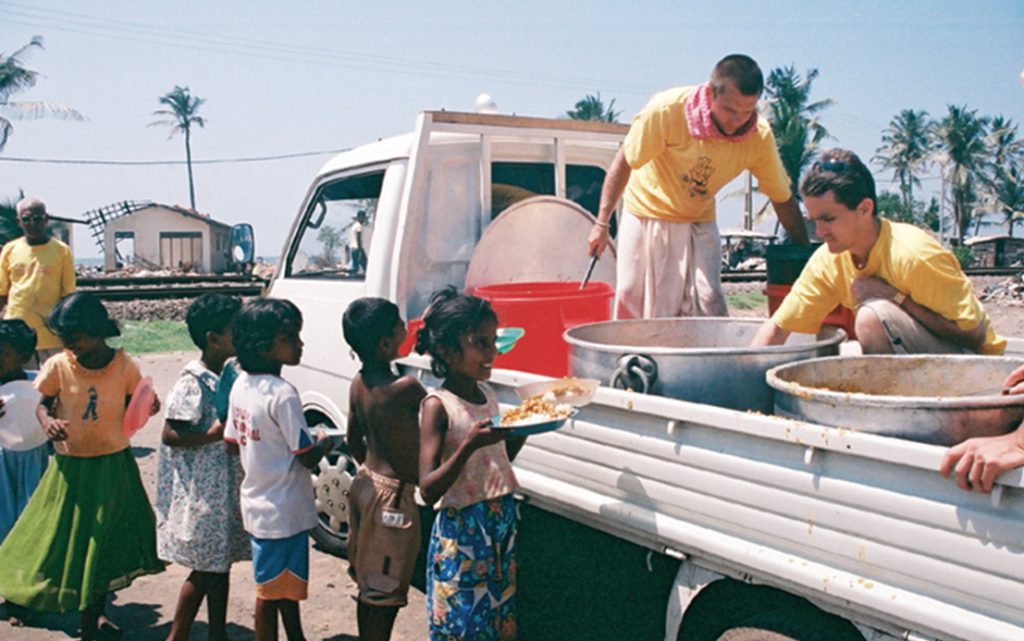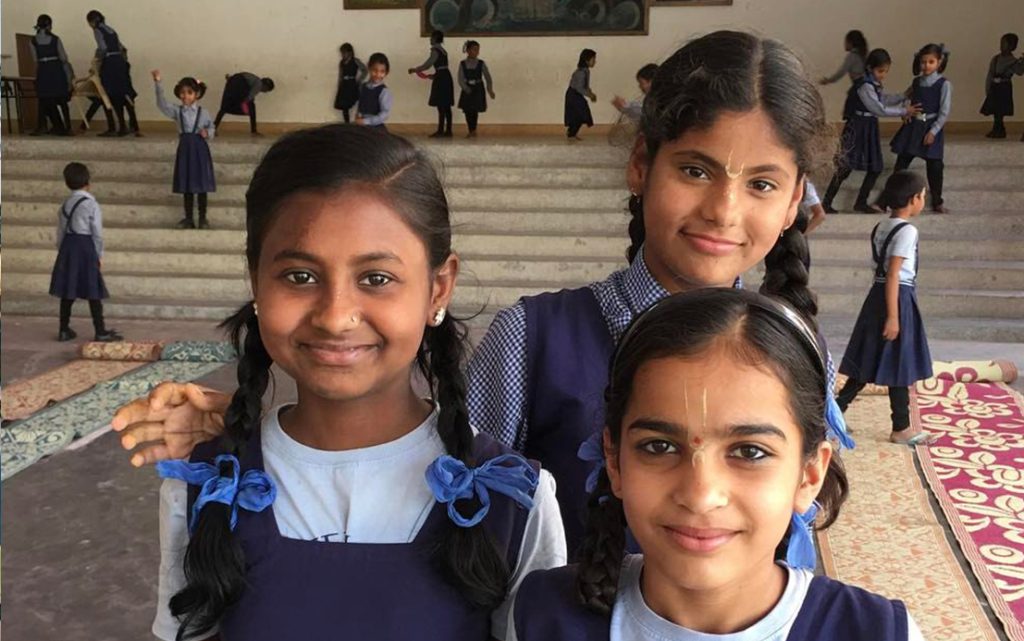Solution to
World Hunger
Our Human Responsibility
Practical Solutions to World Hunger
By Paul Turner, Director of Food Yoga International, formerly known as Food for Life Global
(Originally published January 1999. Updated March 2012)
According to the World Health Organization (WHO), more than one billion people in the world live in poverty today.

Jeremy Rifkin, author of Beyond Beef: The Rise and Fall of the Cattle Industry, comments:
- In Latin America, nearly one out of every eight people go to bed hungry each night. In Asia and the Pacific, 28 percent of the people border on starvation, experiencing the gnawing pain of perpetual hunger. In the Near East, one in ten people is underfed.
- Increased poverty has meant increased malnutrition. On the African continent, nearly one in every four human beings is malnourished.
The World Food Programme
(WFP) Reports
- There are 1.02 billion undernourished people in the world today. That means one in nearly six people do not get enough food to be healthy and lead an active life. Hunger and malnutrition are in fact the number one risk to the health worldwide — greater than AIDS, malaria, and tuberculosis combined. Among the key causes of hunger are natural disasters, conflict, poverty, poor agricultural infrastructure, and over-exploitation of the environment. Recently, financial and economic crises have pushed more people into hunger.
- As well as the obvious sort of hunger resulting from an empty stomach, there is also the hidden hunger of micronutrient deficiencies which make people susceptible to infectious diseases, impair physical and mental development, reduce their labor productivity and increase the risk of premature death.
- Hunger does not only weigh on the individual. It also imposes a crushing economic burden on the developing world. Economists estimate that every child whose physical and mental development is stunted by hunger and malnutrition stands to lose 5-10 percent in lifetime earnings.
- Among the Millennium Development Goals which the United Nations has set for the 21st century, halving the proportion of hungry people in the world is top of the list. Whereas good progress was made in reducing chronic hunger in the 1980s and the first half of the 1990s, hunger has been slowly but steadily rising for the past decade.

Indeed, despite the noble efforts of the WFP and tens of thousands of individuals, World hunger remains a grave problem. The compelling truth is this: never before in human history has such a large percentage of our species—nearly 20 percent—been malnourished. Each year, between 40 million and 60 million people around the world die from hunger and related diseases. Sadly, the toll is heaviest on the world’s children.

Malnutrition
In his forward to UNICEF’s 1998 “State of the World’s Children” report, Secretary-General Kofi Anan spells out a simple but most unassailable truth: “Sound nutrition can change children’s lives, improve their physical and mental development, protect their health, and lay a firm foundation for future productivity.”
Over 200 million children under the age of five in developing countries are malnourished. For them, and for the world at large, Kofi Anan’s message is especially urgent. Malnutrition contributes to more than half of the nearly 12 million deaths of children under five in developing countries each year, and malnourished children who survive often lose precious mental capacity.
The report goes on to explain that 30 years ago, the idea that specific nutrients could help treat specific diseases smacked of “fringe science.”
Today, however, through clinical trials and studies, the fringe is edging closer to the mainstream, and malnutrition’s link to the poor growth of children and adolescents, low-birthweight babies, and a child’s capacity to resist illness has been established scientifically. “It is thus reasonable to argue,” the report states, “that in the global fight to reduce childhood death and illness, initiatives to improve nutrition may be as powerful and important as, for example, immunization programs.”
The right to good nutrition
However far-reaching the benefits of nutrition may be from a clinical viewpoint, ensuring good nutrition is also a matter of international law. The right to proper nutrition is most emphatically proclaimed in the UN’s 1989 Convention on the Rights of the Child. Under the Convention, virtually every government in the world recognizes the right of all children to the highest attainable standard of health, specifically including the right to good nutrition.

Under the Convention’s pre-eminent guiding principle, good child nutrition is a right because it is in the “best interests of the child.” Article 24 of the Convention specifies that States must take “appropriate measures” to reduce infant and child mortality and to combat disease and malnutrition through the use of technology and the provision of adequate, nutritious foods and safe drinking water. In this light, every human being on the planet is responsible for alleviating child malnutrition, based on international law, scientific knowledge, practical experience, and basic human morality.
Hunger in a world
of plenty
The theme for the large international gathering at the United Nations World Food Summit in Rome in 1996 was “Hunger in a world of plenty.” United Nations representatives and non-government organizations (NGOs) from around the world met to discuss ways to solve this global crisis, which continues to escalate and challenge the conscience and sustainability of humankind in the 21st century.
The meeting’s secretary general, Dr. Kay Killingsworth, explained that the problem was not insufficient food production but inequitable distribution. “The result is that the food does not reach the needy.” (See: A change in diets may be necessary to enable developing countries to feed their people, say, scientists (Guardian UK John Vidal, Aug 23, 2004)
Greed not
scarcity
The Vedic scriptures of India provide us with some insight into the nature of compassion and spirituality:
“Everything animate or inanimate being that is within the universe is controlled and owned by the Lord. One should therefore accept only those things necessary for himself, which are set aside as his quota, and one should not accept other things, knowing well to whom they belong.”

By divine arrangement, Mother Nature supplies the needs of all living entities. Overcome with insatiable greed, however, modern society blindly pillages the earth of valuable resources, and thus robs billions of people in developing countries of their God-given quota of food.
This statement is clearly corroborated by the fact that more than one-third of all grain produced in the world is being fed to cattle and other livestock. It appears, therefore, that the solution to world hunger lies beyond the boundaries of expensive and exhausting humanitarian efforts by a few NGOs and that the root cause needs to targeted, namely, greed. For too long individuals and wealthy nations have taken more than their fair share of the Earth’s resources and now must completely cease their selfish gluttony.
Furthermore, when we recognize the equality of all beings, we will naturally want to share the bounty of the earth with others and give up all selfish tendencies. The most damaging expression of selfishness is the growth of factory farming. Vast tracts of land are now needed to grow crops to feed the billions of animals being raised for food each year. According to scientists at the Smithsonian Institute, the equivalent of seven football fields of land is bulldozed every minute, much of it to create more room for farmed animals. Of all the agricultural land in the U.S., nearly 80 percent is used in some way to raise animals—that’s roughly half of the total land mass of the U.S.10 More than 260 million acres of U.S. forest have been cleared to create cropland to grow grain to feed farmed animals. Furthermore, to service the growing demand of animal agriculture, over 35% of all grain production in the world is fed to livestock and not humans.
A worldwide mission
To feed and educate

Food Yoga International, formerly Food for Life Global started in India. Since that time, over five billion free plant-based meals have been served to the needy on six continents. Food Yoga International has emerged as the largest vegan food relief program in the world! Food for Life’s mission— to bring about peace and prosperity through the liberal distribution of pure plant-based food prepared with loving intention—is thus advanced through a twofold strategy:

1. Feeding programs
Food Yoga International currently operates feeding programs through the following distribution channels.
- Lunch meals to school children
- Budget restaurants
- Emergency relief
- Shelters (homeless, single women and men)
- College feeding programs
- Cultural festivals

2. Education
Food Yoga International currently promotes education using following ways
- Public Discourses
- Distribution of Literature
- Networking with other NGOs
- Social Media
- Food Yoga
Food Yoga International is a conscious organization
Our vision is that the world’s problems can be solved by spiritual solutions. Specifically, regarding world hunger, Food Yoga International maintains that when the people of the world recognize the spiritual equality of all beings, they will learn to share equally in the bounty of the earth, and only then will they experience genuine peace and prosperity.
Equal Vision
In its efforts to eradicate world hunger, Food Yoga International trains its volunteers to be selfless, humble, compassionate, equipoised, and broad-minded enough to understand the needs and concerns of the world they live in.
In fact, Food Yoga International network of volunteers often risks their own lives to help those in need. Throughout the fighting in Grozny, Chechnya, for example, Food for Life volunteers cooked and served hot vegan meals to desperate civilians in the war-torn city.

More than one million meals were served during the 20-month conflict. New York Times correspondent Michael Specter visited the volunteers at their kitchen in Chechnya and wrote of them:
“…here they have a reputation like the one Mother Teresa has in Calcutta: it’s not hard finding someone to swear they are saints.”

These volunteers showed tolerance and compassion above and beyond the call of duty, demonstrating true equanimity and a deep understanding of their human responsibility.
Food Yoga International believes that food, so central to the survival of every culture on earth, holds the key to real peace and prosperity. What better way to express that understanding than by educating people on the value of equality and the selfless sharing of pure food?
closing thoughts
Conclusion
We at Food Yoga International, formerly known as Food for Life Global strongly believe that it is the responsibility of every human being on the planet to take action to eradicate malnutrition, which is killing upwards of 12 million children every year. This position, long held by many leading vegetarians, was confirmed by the United Nations 1989 Convention on the Rights of the Child.
Since 1974, Food Yoga International has been committed to the practical response of establishing feeding programs in more than 60 countries throughout the world. However, our resources are very limited; sadly, we are losing the race against world hunger. We, therefore, call out in earnest to all people around the world to accept this human responsibility. It’s time for real action. Establish feeding programs in your area, and make concerted efforts to educate the public about the global benefits of a plant-based diet, and more importantly, embrace this concept of equality as a permanent solution to world hunger. The children of the developing world are depending on you.

GET FOOD YOGA
Nourishing Body, Mind & Soul
Click To Purchase Print Edition
Or Purchase (Kindle EDITION) only $3.15 (English) OR $2.39 (German)
*Prices above are in USD*

purchase a copy of
How to Build a Great Food Relief
Click To Purchase Print Edition
Or Purchase (Kindle EDITION) only $2.22 (English)
*Prices above are in USD*
